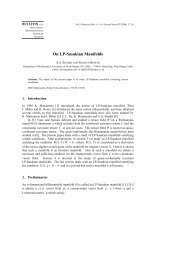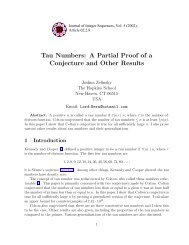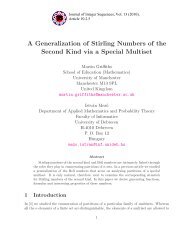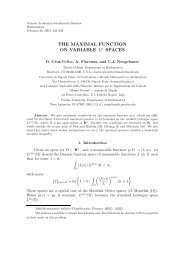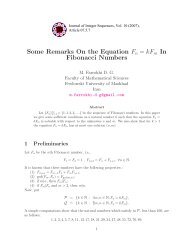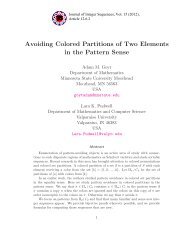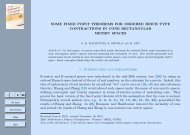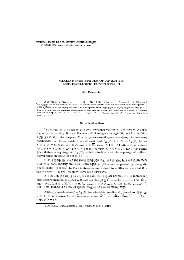stability of retrial queues with versatile retrial policy - European ...
stability of retrial queues with versatile retrial policy - European ...
stability of retrial queues with versatile retrial policy - European ...
You also want an ePaper? Increase the reach of your titles
YUMPU automatically turns print PDFs into web optimized ePapers that Google loves.
Z - I N F O 1 1 / 2 0 1 0HWK Münster, Dortmund. Tel.: 0231/ 55 70 50-25, E-Mail:althaus@ot-forum.de10. November, Informationsveranstaltung „Demografie beiLicht betrachtet – Betriebe gestalten den Wandel“, RegionalagenturWestfälisches Ruhrgebiet, Unna.http://www.regionalagentur-wr.de/de/service/termine/termin_detail.jsp?cid=100515759216510. und 11. November, Seminar „Marktgestaltung”, HWKSüdwestfalen, Arnsberg. Teilnehmergebühr 150 Euro. Tel.:02931/ 877-30911. bis 14. November, Messe „Haus & Wohnen“ in Kölnmit Stand der ZIH unter anderem mit Länder-Quiz,Geschicklichkeitsspiel und Befragung zu Handwerkerleistungenund –image11. November, Seminar Arbeitszeitrecht, Zeitbüro NRW,Dortmund. http://www.arbeit.nrw.de/service/zeitbuero_seminare_anmeldung/index.php12. November, Seminar „Marketingplanung für 2011“,Fachverband des Tischlerhandwerks, Dortmund. Tel.:0231/ 91 20 10-4015. November, Seminar „Mein Betrieb plant Event- undMessemarketing im In- und Ausland“, HWK Dortmund,Dortmund. Tel.: 0231/ 54 93-408, E-Mail:klaus.werthmann@hwk-do.de16. November, Sprechstunde Marketing, HWK Köln, Köln.Tel.: 0221/ 20 22-30917. November, Kongress: Demografischer Wandel, psychischeBelastungen, Krisen - Herausforderungen für dasBetriebliche Gesundheitsmanagement, TÜV Rheinland,Köln. http://www.tuv.com/de/seminare/--klner-bgmkongress-950082101037117.html18. November, Workshop „Internationale Vertragsgestaltung“,HWK Münster und KH Borken, AkademieSchloss Raesfeld. Tel.: 02861/ 89 209-1519. November, Workshop „Marketing mit kleinem Budget“,HWK Südwestfalen, Arnsberg. Teilnehmergebühr 65 Euro.Tel.: 02931/ 877-17723. November, Seminar „Mein Betrieb sucht neue Marktfelder– Mit Kooperationen Absatzmärkte im Auslanderschließen“, HWK Dortmund, Dortmund. Tel.: 0231/54 93-408, E-Mail: klaus.werthmann@hwk-do.de23. November, Workshop „Höhere Produktivität durchMitarbeiterbeteiligung“, HWK Münster, Münster. Tel.: 0251/52 03-024. November, Workshop „Homepage, Online-Werbung,Google-Optimierung für 50plus-Kunden“, HWK Ostwestfalen-Lippe,Bielefeld, Tel.: 0521/ 56 08-11724. und 25. November, Seminar „Verkaufstechnik”, HWKSüdwestfalen, Arnsberg. Teilnehmergebühr 150 Euro. Tel.:02931/ 877-30925. November, Länderseminar Luxemburg, HWKDüsseldorf, Düsseldorf.. Tel.: 0208/ 82 055-32, E-Mail:berck@hwk-duesseldorf.de30. November, Workshop „Flyer und Broschüren für denHandwerksbetrieb“, HWK Köln, Köln. Tel.: 0221/ 20 22-3091. Dezember, Workshop „Mit Öffentlichkeitsarbeit Kundenim In- und Ausland gewinnen“, HWK Düsseldorf,Düsseldorf. Tel.: 0208/ 82 055-39, E-Mail:eichhorn@hwk-duesseldorf.deDas Projekt »Zukunfts-Initiative Handwerk Nordrhein-Westfalen« wird gefördert durch5
6 Stability <strong>of</strong> <strong>retrial</strong> <strong>queues</strong> <strong>with</strong> <strong>versatile</strong> <strong>retrial</strong> <strong>policy</strong>3. Stability <strong>of</strong> the <strong>retrial</strong> queue <strong>with</strong> <strong>versatile</strong> <strong>retrial</strong> <strong>policy</strong>We consider a single server <strong>retrial</strong> queue at which primary customers arrive to the systemat times {t i , i = 1,2,...}. Letτ i = t i+1 − t i be the successive interarrival times, i = 1,2,....If the ith arriving customer finds the server free, he receives service and leaves the system.Otherwise, if the server is busy, the arriving customer moves immediately to an “orbit.”The probability <strong>of</strong> a repeated attempt from the orbit during the interval (t,t + Δt), giventhat j customers were in orbit at time t, is(θ(1 − δ 0j )+jμ)Δt + ◦(Δt). That is, after anexponential random time <strong>with</strong> rate θ (which we will call the orbit <strong>retrial</strong> time), independent<strong>of</strong> the arrival process, each customer in orbit generates a Poisson stream <strong>of</strong> repeatedattempts <strong>with</strong> parameter μ and behaves independently <strong>of</strong> other customers in orbit and<strong>of</strong> the external arrival process. This model, introduced by Artalejo and Gomez-Corral[4], incorporates simultaneously the classical linear <strong>retrial</strong> <strong>policy</strong> and the constant one.If μ = 0, we obtain the constant <strong>retrial</strong> <strong>policy</strong> <strong>with</strong> parameter θ; if the orbit <strong>retrial</strong> timeends before an external arrival, then one customer from the orbit (the customer at thehead <strong>of</strong> the queue or a randomly chosen one) occupies the server. The nth service durationis σ n , and we assume that 0 < Eσ n < ∞. We assume throughout this section that thesequence {σ n } is stationary and ergodic, the interarrival times {τ i } are i.i.d. exponentiallydistributed <strong>with</strong> parameter λ, the interarrival times, orbit <strong>retrial</strong> times, and <strong>retrial</strong> times<strong>of</strong> each customer in orbit are mutually independent and independent <strong>of</strong> the sequence{σ n }.LetX(t) be the number <strong>of</strong> customers in orbit at time t. Defines n to be the instantwhen the (n − 1)st service time ends. We consider the process X(n) embedded immediatelyafter time s n , (i.e., X(n) = X(s + n)). After the end <strong>of</strong> the (n − 1)st service, a competitionbetween two independent (since the orbit <strong>retrial</strong> time and <strong>retrial</strong> times <strong>of</strong> eachcustomer in orbit are independent <strong>of</strong> the interarrival time) exponential laws <strong>with</strong> ratesλ and θ + X(n)μ determines the next customer that gains the server and the probabilitythat a <strong>retrial</strong> time expires earlier than the interarrival time is (θ + X(n)μ)/(λ + θ + X(n)μ).Let u 1 n and u 2 n be two i.i.d. sequences <strong>of</strong> random variables distributed uniformly on [0,1],mutually independent and independent <strong>of</strong> the sequence σ n . u 1 ={u 1 n } will generate thearrival process, and u 2 ={u 2 n} will generate the type <strong>of</strong> arrival (external or from the orbit)at the end <strong>of</strong> the successive service periods. Let ∏ : R + × [0,1] → N denote the inverse <strong>of</strong>the Poisson distribution∏(t,x) = inf{n ∈ N :n∑k=0t k e −tk!≥ x}, (3.1)so that ∏ (t,u 1 n) is a Poisson random variable <strong>with</strong> parameter t. We have the followingrepresentation <strong>of</strong> the process X(n):X(n +1)= ( X(n)+ξ n) +, (3.2)where x + = max[0,x]andξ n = ∏ ( λσn ,u 1 )n − I(u 2 n ≤ θ + X(n)μ )λ + θ + X(n)μ(3.3)is the governing sequence.
T. Kernane and A. Aïssani 7Theorem 3.1. The process X(n) is strong coupling convergent to a unique stationary ergodicregime if one <strong>of</strong> the following conditions is fulfilled:(1) θ>0, μ = 0,andλEσ 1 0,andλEσ 1 < 1.Pro<strong>of</strong>. Consider the case θ>0andμ = 0, then the driving sequence (3.3)hastheformξ n = ∏ ( λσn ,u 1 )n − I(u 2 n ≤ θ ). (3.4)λ + θSince the sequence {u i n } is identically distributed for i = 1,2, and hence stationary, it canbe defined for all integers −∞
8 Stability <strong>of</strong> <strong>retrial</strong> <strong>queues</strong> <strong>with</strong> <strong>versatile</strong> <strong>retrial</strong> <strong>policy</strong>hence there is a number n 0 = n 0 (a)suchthatP(A n ) > 0forn ≥ n 0 . If, on the other hand,the events B n ,thenumberm, and the function g : R m+1 → R are defined asm = n 0 , B n = T m A n , g ( y 0 ,..., y m)≡ y+m , (3.11)then the events B n ∈I ξ n+m are renovating for {X(n)} on the segment [n,n + m] foralln ≥ 0, so one can assume that n 0 = 0. Hence, using Theorem 2.7, the sequence {X(n)}is strong coupling convergent to a unique stationary sequence {X n ≡ U n X 0 },whereX 0is I σ,u -measurable, obeying the equation X n+1 = (X n + ξ n ) + , and the ergodicity followsfrom Remark 2.4 and the fact that X n is compatible <strong>with</strong> the shift U.Let us now consider the case θ ≥ 0andμ>0. The renovation events A n will be constructednow in two steps. We will first introduce a majorizing SRS X(n) ∗ on the sameprobability space, which will enable us to obtain simple stationary renovating events A ∗ n<strong>with</strong> positive probability, and A n will be obtained as some subsets <strong>of</strong> A ∗ n .TheSRSX(n) ∗has the following form:X(0) ∗ = X(0),X(n +1) ∗ = max ( )C,X(n) ∗ + ξn∗ , (3.12)whereξn ∗ = ∏ ( λσn ,u 1 )n − I(u 2 n ≤ θ + Cμ ). (3.13)λ + θ + CμThe sequence {ξ ∗ n } is measurable <strong>with</strong> respect to Iσ,u and ξ ∗ n+1 = Uξ ∗ n . From this andRemarks 2.3 and 2.4 it follows that the sequence {ξ ∗ n } is stationary and ergodic. We choosethe constant C such that Eξ ∗ n < 0 if the condition λEσ 1 < 1holds,whereE ( )ξn∗ = λEσ1 − θ + Cμλ + θ + Cμ . (3.14)It follows that there exist renovation events A ∗ n = Tn A ∗ 0 , n ≥ n 0 ,whereA ∗ 0 is defined as(3.7) <strong>with</strong> the sequence {ξn ∗},suchthatX(n)∗ = C on the set A ∗ n for all n ≥ n 0 .Definethe sets{ ∏ (B 0 = λσ−k ,u 1 )−k = 0, u2−k ≤ θ + kμ}λ + θ + kμ , k = 1,...,C , B n = T n B 0 . (3.15)The sets A n = A ∗ n−C ∩ B n form a stationary renovating sequence for X(n), since for all n ≥n 0 + C,wehaveonA n ,thevaluesX(n − k) ≤ k, k = 0,1,...,C, and in particular, X(n) = 0.Moreover, P(A 0 ) = P(A ∗ −C) P(B 0 | A ∗ −C) > 0 (see Altman and Borovkov [2, pages 353-354]). The strong coupling convergence <strong>of</strong> the process X(n) to a stationary ergodic regimefollows from Theorem 2.7.□Remark 3.2. Although the conditions <strong>of</strong> Theorem 3.1 are sufficient for <strong>stability</strong>, we canassert that they are necessary, since for SRS <strong>of</strong> the form X(n +1)= (X(n)+ξ n ) + ,the
T. Kernane and A. Aïssani 9condition Eξ n > 0 implies that the process X(n) converges in distribution to an improperlimiting sequence, that is, X(n) →∞almost surely, and it can be extended under wideassumptions to the case Eξ n = 0 (see Borovkov [8, Theorem 1.7]).4. Stability <strong>of</strong> the <strong>retrial</strong> queue <strong>with</strong> two types <strong>of</strong> customersConsider now a <strong>retrial</strong> queue <strong>with</strong> two types <strong>of</strong> arriving customers, known as “impatient”and “persistent.” If an impatient customer finds the server busy, then he leaves the system.On the other hand, if a persistent customer arrives and finds the server busy, then he mayhave access to the orbit and waits to be served later according to the <strong>versatile</strong> <strong>retrial</strong> <strong>policy</strong>described above. Assume that the interarrival times {τn 1} <strong>of</strong> type 1 (impatient) and {τ2 n }<strong>of</strong> type 2 (persistent) are sequences <strong>of</strong> independent and identically distributed randomvariables <strong>with</strong> exponential distributions <strong>with</strong> parameters λ 1 > 0andλ 2 > 0, respectively.The service times {σn 1} (for type 1) and {σ2 n } (for type 2) are stationary and ergodic,independent <strong>of</strong> each other and <strong>of</strong> {τn 1}, {τ2 n }, orbit <strong>retrial</strong> times and <strong>retrial</strong> times <strong>of</strong> eachcustomer in orbit, and 0 < E(σn) j < ∞, j = 1,2. The sequences {τn}, 1 {τn}, 2 orbit <strong>retrial</strong>times and <strong>retrial</strong> times <strong>of</strong> each customer in orbit are independent <strong>of</strong> each other. Let X(t)bethenumber<strong>of</strong>customersinorbitattimet. Defines n to be the instant when the (n −1)st service time ends. We consider the process X(n) embedded immediately after times n , (i.e., X(n) = X(s + n)). Let u 1 n and u 2 n defined as in Section 3, and independent <strong>of</strong> thesequences {σn 1} and {σ2 n },exceptthatu2 = u 2 n will generate now the type <strong>of</strong> request <strong>of</strong>service: impatient customer, external persistent customer or persistent customer fromthe orbit at the end <strong>of</strong> the successive service periods. The representation <strong>of</strong> the processX(n)isX(n +1)= ( X(n)+ξ n) +, (4.1)where the driving sequence {ξ n } is now <strong>of</strong> the formξ n = ∏ )(λ2 σn,u 1 1 )n I(u 2 n ≤ λ 1λ 1 + λ 2 + θ + X(n)μ+ ∏ ()(λ2 σn,u 2 1 ) λn I 1λ 1 + λ 2 + θ + X(n)μ
10 Stability <strong>of</strong> <strong>retrial</strong> <strong>queues</strong> <strong>with</strong> <strong>versatile</strong> <strong>retrial</strong> <strong>policy</strong>Pro<strong>of</strong>. Consider the first case θ>0andμ = 0. Then the sequence {ξ n } has the formξ n = ∏ )(λ2 σn,u 1 1 )n I(u 2 n ≤ λ 1λ 1 + λ 2 + θ+ ∏ ((λ2 σn,u 2 1 ) λn I 1λ 1 + λ 2 + θ
12 Stability <strong>of</strong> <strong>retrial</strong> <strong>queues</strong> <strong>with</strong> <strong>versatile</strong> <strong>retrial</strong> <strong>policy</strong>Define the σ-algebras I σ,u,r n = σ(σ k ,r (k) ,u (k) ,u 1 k ,u2 k ,u3 k ; k ≤ n) and Iσ,u,r = σ(σ k ,r (k) ,u (k) ,u 1 k ,u2 k ,u3 k ; −∞
T. Kernane and A. Aïssani 13process <strong>of</strong> the regular customers, u 2 ={u 2 n } will generate the arrival process <strong>of</strong> the negativecustomers, and u 3 n will generate the type <strong>of</strong> arrival that gains the server (external orfrom the orbit) at the end <strong>of</strong> the successive service periods. Let X(n)bedefinedasaboveand it has now the following representation:X(n +1)= ( X(n)+ζ n − η n) +, (6.1)whereζ n = ∏ ( λσn ,u 1 )n − I(u 3 n ≤ θ + X(n)μ ), (6.2)λ + θ + X(n)μη n = ∏ ( δσn ,u 2 n) . (6.3)Theorem 6.1. The process X(n) is strong coupling convergent to a unique stationary andergodic regime if one <strong>of</strong> the following conditions is fulfilled:(1) θ>0, μ = 0,and((λ − δ)(λ + θ)/θ)Eσ 1 < 1;(2) θ ≥ 0, μ>0,and(λ − δ)Eσ 1 < 1.Pro<strong>of</strong>. Consider the first case θ>0andμ = 0. Then the sequence (6.2)hastheformζ n = ∏ ( λσn ,u 1 )n − I(u 3 n ≤ θ ). (6.4)λ + θDefine the σ-algebras I σ,u n= σ(σ k ,u 1 k ,u2 k ,u3 k ; k ≤ n) andIσ,u = σ(σ k ,u 1 k ,u2 k ,u3 k ; −∞
14 Stability <strong>of</strong> <strong>retrial</strong> <strong>queues</strong> <strong>with</strong> <strong>versatile</strong> <strong>retrial</strong> <strong>policy</strong>7. Stability <strong>of</strong> the <strong>retrial</strong> queue <strong>with</strong> batch arrivalsConsider a single server <strong>retrial</strong> queue <strong>with</strong> the <strong>versatile</strong> <strong>retrial</strong> <strong>policy</strong>. Let us now considerthat at every arrival epoch t k , k = 1,2,...,arandombatch<strong>of</strong>a k customers enters the system.If the server is busy at the arrival epoch, then the whole batch <strong>of</strong> customers joins theorbit, whereas if the server is free, then one <strong>of</strong> the arriving customers starts his serviceand the others join the orbit. We assume that the input flow <strong>of</strong> customers occurs accordingto a Poisson process <strong>with</strong> rate λ, the sequence <strong>of</strong> batch sizes {a k } is independent andidentically distributed <strong>with</strong> general distribution and mean a, where0< a0andμ = 0, so the driving sequence (7.2) will have thefollowing form:ξ n =∏ (λσn,u 1 n)∑k=1a (n)k + ( a 1 − 1 ) (I u 2 n ≤λ ) ( )λ− Iλ + θ λ + θ
T. Kernane and A. Aïssani 15and if the condition λaEσ 1 < (λ(1 − a)+θ)/(λ + θ) holds,thenEξ n < 0. The conditionλ(a − 1) 0. The majorizing SRS has now theformX ∗ (0) = X(0),X ∗ (n +1)= max ( )C,X ∗ (n)+ξn∗ , (7.5)where∏ (λσn,u 1 n)ξn ∗ = ∑k=1a (n)k + ( a 1 − 1 ) (I u 2 n ≤) (λ− Iλ + θ + Cμ)λλ + θ + Cμ



